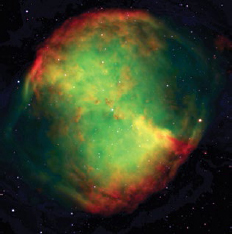1764
Planetary Nebulae
Charles Messier (1730–1817), William Herschel (1738–1822)
The advent of telescopes in the seventeenth century, and significant improvements in their size and ability to detect faint objects in the eighteenth century, enabled exciting new discoveries by astronomers during the Enlightenment. Not just fainter stars, but entire new classes of objects became visible. The largest class comprised fuzzy, extended patches of light that resembled faint, fixed clouds among the stars. Astronomers called them nebulae (singular: nebula)—Latin for “clouds.”
A number of bright nebulae had been recorded by ancient and medieval astronomers, such as the Orion nebula and a nebula in Andromeda later recognized by twentieth-century astronomers to be a separate galaxy. Edmond Halley published a short list of nebulae in 1715. The crown prince of eighteenth-century nebular observations, however, was the French astronomer Charles Messier, who developed a definitive early catalog of more than one hundred nebulae.
One kind of nebula that Messier noted was typified by an object that he discovered in 1764 and catalogued as object M27. With a somewhat circular, fuzzy appearance, M27 and similar objects looked a lot like the giant planets in telescopes of the day, causing the English astronomer William Herschel to dub them “planetary nebulae.”
The choice of name stuck but was unfortunate, as modern spectroscopy observations show these objects to have nothing to do with planets at all. Rather, planetary nebulae have since been revealed to be enormous, expanding shells of hot, glowing gases ejected from red giant stars near the end of their stellar lifetimes. Typical planetary nebulae can be more than a light-year across, and they glow from the emission of ionized carbon, oxygen, nitrogen, and other elements heavier than hydrogen and helium created during the collapse of their precursor stars. As such, planetary nebulae are part of a cosmic recycling program that turns hydrogen and helium into heavier elements and, eventually, life.

The Dumbbell Nebula (Messier’s M27), photographed in 1998 from the European Southern Observatory in Chile.
SEE ALSO Chinese Observe “Guest Star” (185), Andromeda Sighted (c. 964), “Daytime Star” Observed (1054), Mira Variables (1596), Orion Nebula “Discovered” (1610), Messier Catalog (1771), End of the Sun (5–7 Billion).
Hubble Space Telescope photo from 1994 of the Cat’s Eye Nebula (NGC 6543), a spectacular example of a multishelled planetary nebula created as a dying star sheds its outer layers.
